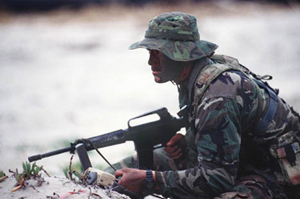
Tired yet? Well the fun is just beginning. It takes about five years to train a SEAL up to a high level of competence in all skill and mission areas. BUD/S is BASIC individual training. Now the prospective SEAL must check into his SEAL Team, assume the “new guy” role and start to learn how to operate as an elite commando unit. This mandatory four-month course is the first step.
SEAL Qualification Training primarily focuses on the basics, but takes the individual’s skill levels to a higher plateau. Also, students start to learn how to operate as a team. The course is a little over four months in length and starts with classroom training in mission planning and intelligence gathering and reporting. Students then begin a series of “blocks” of training covering the major skills required to conduct SEAL missions. These include Hydrographic Reconnaissance, Communications, Field Medicine, Air Skills, Combat Swimmer, Land Warfare, Maritime Operations (long range ocean navigation) and Submarine Lock-in/Lock-out.
During Air week the class can expect to conduct day and night static line jumps, a water jump accompanied by a “rubber duck” – a zodiac boat with motor and gear sent out of the back of a C-130 under canopy, followed by six frogmen to chase it to the water. Fastrope techniques, whereby a SEAL slides down a nylon rope for 80 feet using only gloved hands to brake, and rappelling are taught. Finally, the “Special Insertion/Extraction” (SPIE) rig is introduced – allowing six to eight SEALs to be removed from an area too rugged or dense to land a helicopter.
During combat swimmer training the class will conduct over 25 day and night compass dives, starting again from the basics and progressing to full mission profile combat swimmer submerged ship attacks against Naval Vessels.
Land Warfare training is usually conducted at the Naval Special Warfare training facility at Niland, Ca. for the West Coast Teams or at Camp A.P Hill for the East Coast teams. This training lasts three weeks and is similar in content to the San Clemente Land Warfare – except at a much more advanced level. Students enhance their skills in patrolling, improvised booby traps, stalking, weaponry and military demolition. They begin to practice the fine art of live fire immediate action drills, which have the team firing and maneuvering in well-choreographed sequences. These drills become quite interesting at night using pop up targets and pop flares and smoke grenades – all creating confusion and chaos – which emulates the “fog” of battle pretty well.
Often the squads get split up and disoriented – especially during the famed “gauntlet” at Niland where the squad patrols through a course with multiple and simultaneous “hits” that they must analyze and react to, suppress fire and get out of the kill zone! WOW, what a rush! Bullets fly all over the place, team members scream to communicate over the noise, smoke grenades go off and pop flares light up the night sky then fizzle out. All this is going on while SEALs endure sweat, fear, exhilaration and confusion, along with the ever- present desire to perform the drill better each time because they know that their life depends upon the level of competence of the team in a real firefight. The motto the more you sweat in peacetime the less you bleed in war is constantly drilled into your head. Train as you would fight – this is Navy SEAL Training at it’s best folks!
